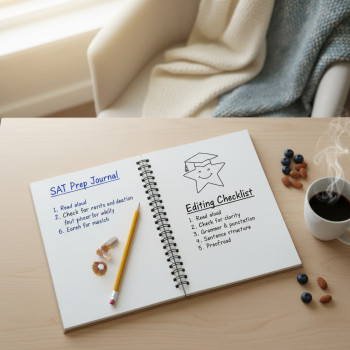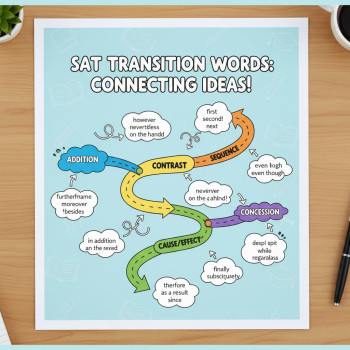How to Prep for the SAT If You’re a Morning Person
If your brain blooms with the sunrise, you already have a scientist-approved advantage when it comes to studying for the SAT. Morning people—those who feel alert, creative, and focused in the hours right after waking—can harness that early energy for concentrated, high-quality prep. This guide turns that natural rhythm into an SAT-winning routine. You’ll find realistic sample schedules, science-backed tips on sleep and nutrition, specific morning practice techniques for Reading, Writing & Language, and Math, and test-day rituals that preserve your peak state. I’ll also weave in how Sparkl’s personalized tutoring—1-on-1 guidance, tailored study plans, expert tutors, and AI-driven insights—can fit naturally into a morning-centric prep plan.
Why mornings can be the best time to study for the SAT
Not everyone studies the same way. If you notice you absorb new information quickly, make fewer careless errors, and handle complex thinking tasks early in the day, that’s your cue to make mornings sacred. Here’s why mornings work:
- Fewer distractions: Early hours tend to be quieter—fewer texts, fewer social media impulses, and less household noise.
- Higher executive function: The brain’s prefrontal cortex often performs well shortly after waking, supporting planning, attention, and problem-solving.
- Consistency and momentum: Morning routines are easier to stick with—when you get studying done first, the rest of your day is free from guilt and rushed catch-up.
Quick self-check: Are you a morning person?
It’s simple to test yourself over a week. Keep a small journal and note during morning study blocks how alert you feel, how many problems you solve correctly, and your emotional state (stressed, calm, engaged). If you consistently feel sharper at 6–10 AM than at 8–11 PM, morning prep is your advantage.
Design a morning routine that supports focused SAT work
Ritual matters. A reliable sequence signals your brain that it’s time for deep work. The goal is to move from waking to focused study in a way that feels energizing, not frantic.
Sample 90-minute morning routine
This routine balances wake-up essentials with a solid study block. Tailor the times to fit your school start time and test-day schedule.
- 6:00 AM — Wake up and get natural light. Open curtains or step outside for 5 minutes.
- 6:05–6:20 AM — Hydrate and a light movement: stretch, walk, or 5–10 minutes of yoga to raise circulation.
- 6:20–6:30 AM — Quick, protein-rich breakfast (Greek yogurt + berries, eggs on toast, or peanut butter and banana).
- 6:30–7:00 AM — Warm-up: 10–15 minutes of vocabulary review or quick grammar drills; 15–20 minutes of a timed math section question set.
- 7:00–8:00 AM — Deep study block: one focused task (practice test section, intensive review, or targeted problem sets).
- 8:00 AM — Short reflection: note what worked and what to adjust tomorrow.
Why light, hydration, and movement matter
Natural light helps regulate your circadian rhythm and signals alertness. Hydration improves cognitive performance and reduces fatigue—start with a glass of water before coffee. Movement wakes up the body and boosts blood flow to the brain, improving attention for that study block.

Set your sleep schedule to optimize morning performance
It’s tempting for morning people to skimp on sleep because they wake early naturally, but consistent, sufficient sleep is non-negotiable for peak SAT performance. The SAT tests reasoning, memory, and focused attention—functions that suffer with sleep debt.
Target sleep windows
Aim for 8–9 hours of sleep on consistent nights. If your test starts at 8:30 AM, plan to wake two to three hours earlier—practice that wake time during your prep weeks so your circadian clock is ready.
| Wake-up time | Recommended bedtime (8 hours) | Recommended bedtime (9 hours) |
|---|---|---|
| 5:30 AM | 9:30 PM | 8:30 PM |
| 6:00 AM | 10:00 PM | 9:00 PM |
| 6:30 AM | 10:30 PM | 9:30 PM |
Using a consistent bedtime and wake time reduces grogginess and gives you a reliable morning state for studying. If social factors push your bedtime later, plan naps strategically—no more than 20–30 minutes, and not too late in the afternoon.
Power of a test-day rehearsal
Two weeks before test day, pick a weekend Saturday and replicate the test day: wake at your target time, eat the test-day breakfast, and take a full-length practice test that begins at the same time as your actual SAT. Practicing under those conditions builds habit and reduces morning anxiety.
How to structure morning study blocks for the SAT
Morning study should be high-quality, not just long. Use short, focused blocks with a single objective, followed by clear reflections and actionable steps.
Block strategy (for a 60–90 minute session)
- 10–15 minute warm-up: quick review, flashcards, or mental math.
- 40–60 minute deep work: one focused activity—timed Reading section, focused grammar drills, or a set of medium-difficulty math problems.
- 10–15 minute review: analyze mistakes, write one sentence on a strategy to try next session.
What to practice in the morning vs. evening
Use mornings for tasks that require raw reasoning and clear-headed analysis. Save review, error analysis, and creative tasks for the afternoon or evening if that’s when you’re less sharp but still available.
- Best for mornings: timed Reading passages, multi-step Math problems, dense Writing & Language sections, and full-length practice tests.
- Best for evenings: reviewing missed questions, rewriting explanations in your own words, planning next day’s study goals.
Morning strategies by SAT section
Reading
Mornings are perfect for reading comprehension because they require sustained attention and inference-making. Develop a routine:
- Start with a 5-minute active reading warm-up: read a short op-ed or science paragraph and summarize aloud.
- Practice focused passage sets: 1–2 passages in 30–40 minutes, with strict timing and self-monitoring.
- Use a two-pass strategy on test day: first answer the low-effort questions (detail, line reference), then return to the inference-heavy ones.
Writing & Language
Grammar and clarity problems respond well to repetition. In the morning, alternate between timed sections and focused grammar drills from the rules you most frequently miss. Keep a short rule-log: five grammar rules you mess up on, and review them for five minutes before your study block.
Math
Complex problem solving and algebra are excellent morning targets. Begin with warm-up number sense: quick mental arithmetic or fraction problems. Then tackle medium-to-hard practice sets when your mind is most alert to reduce careless errors and spot shortcuts.
Practice tests: do them in the morning
One of the clearest advantages for morning people is to take practice tests at the same time as the real SAT. That conditions your mind and body to peak performance during the exam window.
How to schedule practice tests
- Take a full-length practice test (with timed sections and breaks) once every 1–2 weeks during your main prep window.
- Start them at your planned test day wake time—if your real SAT begins at 8:30 AM, start the practice test at 8:30 AM.
- After each test, spend equal time reviewing mistakes and rewriting solutions. The morning’s high-quality focus makes these reviews more meaningful.
| Week | Morning Practice Focus | Goal |
|---|---|---|
| 1–2 | Establish wake time, light exposure, quick vocab, and timed section practice | Create consistency and baseline diagnostic |
| 3–5 | Target weak areas in Reading/Writing/Math during morning deep blocks | Raise section scores by focused practice |
| 6–8 | Full-length morning practice tests and fine-tuning strategy | Simulate test-day conditions and cement habits |
Nutrition and quick meals that sustain morning focus
What you eat before a morning study block or the test matters. Aim for satiety and steady energy without sugar crashes.
Easy breakfast options
- Greek yogurt with nuts and berries — protein, healthy fat, and antioxidants.
- Oats with a scoop of nut butter and a sliced banana — slow-release carbs and protein.
- Two eggs and whole-grain toast — savory and satisfying for longer attention spans.
- Peanut butter on a rice cake with apple slices — quick and portable for test day.
Avoid heavy greasy food that can make you sluggish and sugary cereals that cause crashes. Test-day hydration is essential: water first, then a moderate caffeine boost if you usually have coffee. Don’t try a new food on test day.
Mindset, motivation, and dealing with morning nerves
Even morning people feel jitters. Successful prep balances confidence with practical habit-building.
Short mental warm-ups
- Two-minute breathing or box-breathing exercise before a study block to reduce cortisol and sharpen focus.
- One quick positive statement: “I’ve practiced this time and again; today I’ll stay calm and deliberate.”
- Micro-goals each morning: select one clear result (e.g., finish one timed Reading passage and review errors).
Use mistakes as signals
When you make a repeated mistake, that’s the place to invest time. Keep an error log and schedule a morning session to drill just those question types—targeted practice in the morning is more likely to stick than a scattershot evening scramble.
Sample 8-week morning-focused study plan
Below is a practical template you can adapt. It assumes school or other daytime commitments and concentrates your heaviest work into the morning window when you’re most alert.
| Week | Morning Sessions (per week) | Focus |
|---|---|---|
| 1 | 4 × 60–90 min | Diagnostic, build consistent wake time, basic drills |
| 2–4 | 4–5 × 60–90 min | Section-targeted work, time-management strategies |
| 5–6 | 3–4 × 90–120 min (include one long practice test) | Increase difficulty, simulate testing conditions |
| 7–8 | 2–3 × 90–120 min (full-length tests) | Test-day rehearsals, strategy refinement, light tuning |
This schedule preserves recovery time and reduces burnout. It also mirrors how morning people maintain peak cognitive performance without overextending the day.
How personalized tutoring fits your morning routine
Personalized tutoring is especially powerful for morning learners. When your tutor knows you’re a morning person, sessions can be scheduled at your prime time so you get the most effective 1-on-1 guidance. Tutors can build a tailored study plan that leverages morning deep work for problem-solving and reserves lower-stakes review for evenings.
What to expect from morning-focused tutoring
- 1-on-1 guidance aligned with your natural daily rhythm—timed practice when you’re sharp.
- Tailored study plans that concentrate new, demanding material in the morning.
- Expert tutors who give immediate feedback and help you analyze errors while your memory is fresh.
- AI-driven insights that track progress and suggest optimal morning practice items based on your performance.
With personalized support, you spend less time guessing what to study and more time making measurable gains. If you use a service like Sparkl’s personalized tutoring, you can marry data-driven plans with human coaching to keep your morning momentum moving toward real score improvement.
Day-before and test-morning checklist
Preparation the night before and the morning of the test reduces surprises and preserves calm focus.
- Night before: layout your ID, admission ticket, simple breakfast, calculator (fresh battery), and watch.
- Sleep: get your normal amount; no late-night cramming.
- Test morning: wake early enough for your full routine (light, hydrate, brief movement, breakfast).
- During the test: use your usual timing strategies, and if you get an early energy dip, use a quick, silent breathing reset.

Realistic example: Aisha’s morning transformation
Aisha was a classic morning person who read faster and solved algebra quicker before noon. She started by shifting all her most important practice to 7–9 AM. With a tutor, she created a tailored plan: mornings for timed Reading and hard Math, evenings for error logs and concept review. Over eight weeks, Aisha’s practice test scores rose by 80–120 points. The change was less about cramming and more about aligning study difficulty with her cognitive peak. Her tutor from Sparkl’s worked with her to set morning goals and used AI-driven insights to pick the exact problem types she needed each session.
Common mistakes morning people make—and how to avoid them
- Skipping sleep to study more: Short-term gains collapse into long-term losses. Prioritize consistent sleep.
- Overdoing it early: Peak focus has limits—don’t turn every morning into a marathon. Mix intense blocks with light review days.
- Ignoring nutrition and light: Both are low-effort, high-impact. A quick walk outside and protein-rich breakfast beat extra hours with no energy.
- Practicing only content you like: Morning strengths can make you avoid weaknesses. Schedule one difficult topic per week to tackle when you’re sharp.
Final pep talk: make mornings your secret weapon
When you prep for the SAT as a morning person, you’re not forcing your brain into someone else’s schedule—you’re honoring how you’re built to learn. That gives you a sustainable advantage. Use consistent wake times, light exposure, short movement, balanced breakfasts, targeted morning study blocks, and regular timed practice tests. Couple those habits with personalized tutoring—1-on-1 guidance, tailored study plans, expert tutors, and AI-driven insights—and you move from guesswork to precision. You’ll not only raise scores but also enter test day calm, practiced, and ready to think at your best.
One last practical checklist for tomorrow morning
- Set your alarm to your planned test-week wake time.
- Place a glass of water and breakfast waiting.
- Schedule one focused 60–90 minute block: decide the section and the goal.
- Write down one improvement target for tomorrow’s review session.
Start tomorrow morning with intention. When you pair your natural early-bird gifts with a thoughtful plan, the SAT becomes less of a test and more of a chance to show what your best, well-rested brain can do.


















No Comments
Leave a comment Cancel